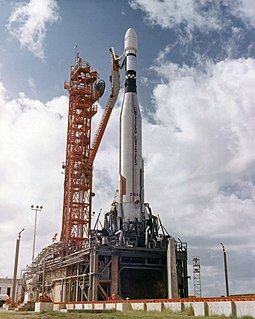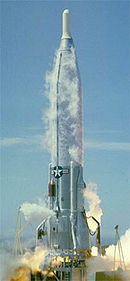Related Research Articles

Cape Canaveral Space Force Station (CCSFS) is an installation of the United States Space Force's Space Launch Delta 45, located on Cape Canaveral in Brevard County, Florida.

The PGM-17A Thor was the first operational ballistic missile of the United States Air Force (USAF). Named after the Norse god of thunder, it was deployed in the United Kingdom between 1959 and September 1963 as an intermediate-range ballistic missile (IRBM) with thermonuclear warheads. Thor was 65 feet (20 m) in height and 8 feet (2.4 m) in diameter. It was later augmented in the U.S. IRBM arsenal by the Jupiter.

The PGM-19 Jupiter was the first nuclear armed, medium-range ballistic missile (MRBM) of the United States Air Force (USAF). It was a liquid-propellant rocket using RP-1 fuel and LOX oxidizer, with a single Rocketdyne LR79-NA rocket engine producing 667 kilonewtons (150,000 lbf) of thrust. It was armed with the 1.44 megatons of TNT (6.0 PJ) W49 nuclear warhead. The prime contractor was the Chrysler Corporation.

Space Launch Complex 41 (SLC-41), previously Launch Complex 41 (LC-41), is an active launch site at Cape Canaveral Space Force Station. As of 2020, the site is used by United Launch Alliance (ULA) for Atlas V launches. Previously, it had been used by the USAF for Titan III and Titan IV launches.

Cape Canaveral Launch Complex 5 (LC-5) was a launch site at Cape Canaveral Space Force Station, Florida used for various Redstone and Jupiter launches.

Launch Complex 36 (LC-36)—formerly known as Space Launch Complex 36 (SLC-36) from 1997 to 2010—is a launch complex at Cape Canaveral Space Force Station in Brevard County, Florida. It was used for Atlas launches by NASA and the U.S. Air Force from 1962 until 2005.
Launch Complex 10 (LC-10) at Cape Canaveral Space Force Station, Florida was a launch pad used by SM-64 Navaho missiles, and later Jason sounding rockets and the Alpha Draco research missile. It was located north of Launch Complex 17, where Launch Complexes 31 and 32 are now located.

Launch Complex 11 (LC-11) at Cape Canaveral Space Force Station, Florida, is a launch complex used by Atlas missiles between 1958 and 1964. It is the southernmost of the launch pads known as Missile Row. When it was built, it, along with complexes 12, 13 and 14, featured a more robust design than many contemporary pads, due to the greater power of the Atlas compared to other rockets of the time. It was larger, and featured a concrete launch pedestal that was 6 metres (20 ft) tall and a reinforced blockhouse. The rockets were delivered to the launch pad by a ramp on the southwest side of the launch pedestal.

Launch Complex 12 (LC-12) at Cape Canaveral Space Force Station, Florida was a launch pad used by Atlas rockets and missiles between 1958 and 1967. It was the second-most southern of the pads known as Missile Row, between LC-11 to the south and LC-13 to the north. Along with Complexes 11, 13 and 14, 12 featured a more robust design than many contemporary pads, due to the greater power of the Atlas compared to other rockets of the time. It was larger, and featured a concrete launch pedestal that was 6 metres (20 ft) tall and a reinforced blockhouse. The rockets were delivered to the launch pad by means of a ramp on the southwest side of the launch pedestal.

Launch Complex 13 (LC-13) was a launch complex at Cape Canaveral Space Force Station, the third-most southerly of the original launch complexes known as Missile Row, lying between LC-12 and LC-14. In 2015, the LC-13 site was leased by SpaceX and was renovated for use as Landing Zone 1 and Landing Zone 2, the company's East Coast landing location for returning Falcon 9 and Falcon Heavy launch vehicle booster stages.

Launch Complex 18 (LC-18) is a launch complex at the Cape Canaveral Space Force Station, Florida that was active during the late 1950s and early 1960s. It was used by Viking, Vanguard, Thor and Scout rockets. The complex consists of two launch pads, LC-18A, which was originally built by the US Navy for the Vanguard rocket, and LC-18B, which was originally by the US Air Force used for tests of the PGM-17 Thor missile.
Launch Complex 25 (LC-25) was a four-pad launch site at Cape Canaveral Space Force Station, Florida built for test flights of the US Navy's submarine-launched ballistic missiles Polaris, Poseidon and Trident from 1958–1979.

The 6555th Aerospace Test Group is an inactive United States Air Force unit. It was last assigned to the Eastern Space and Missile Center and stationed at Patrick Air Force Base, Florida. It was inactivated on 1 October 1990.
References
- McDowell, Jonathan. "Atlas". Orbital and Suborbital launch database. Jonathan's Space Page. Retrieved 2009-04-19.
- Wade, Mark. "Atlas". Encyclopedia Astronautica. Archived from the original on August 14, 2008. Retrieved 2009-04-19.

